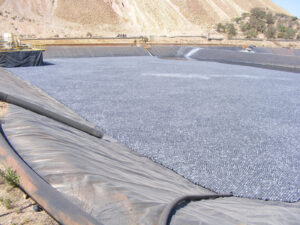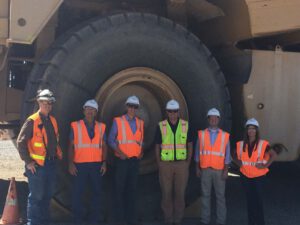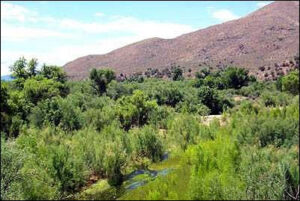Arizona is a state that has endured difficult water challenges since its founding over a century ago. Its arid climate, varied terrain, and position on the Colorado River relative to other states have often created conflicts among various water users. Sandy Fabritz, the director of water strategy at mining company Freeport-McMoRan, is someone who has not only seen those challenges from various perspectives, but has used her experience to find mutually beneficial solutions to complex water issues. In this interview, Ms. Fabritz tells Irrigation Leader about the path that led her to both public service and the private sector, how Freeport-McMoRan prioritizes environmental and water conservation, and the importance of cooperation among Arizona’s water users in addressing the challenges of the future.
Irrigation Leader: Please tell us about your background and how you came to be in your current position.
Sandy Fabritz: My work experience started in California, where I worked as a draftsman for a construction and engineering firm in the oil and gas industry. I did that for a couple of years and then decided that I really needed to get back to Arizona, my family, and what I really wanted to do. At the time, what I thought I really wanted to do was work outdoors and have a little bit of freedom. I went back to Arizona State University and got a degree in environmental resources in agriculture with an emphasis on range management. During that time, one of my professors came to me and told me about a paid internship at the Arizona Department of Water Resources (ADWR). Summer was coming, and I decided to give it a shot. Well, I basically stuck around for almost 25 years, working in various jobs. I actually left for a short stint with the City of Chandler, but went right back to the ADWR afterward. I became director under Governor Brewer in 2010. I loved working for the ADWR and the State of Arizona; it was a good position with a lot of opportunities. As Governor Brewer’s term was coming to an end, I was approached by Freeport-McMoRan to see if I would be interested in becoming the director of water strategy there. That’s what I did, I’ve been there ever since, and I am happy to be there.
Irrigation Leader: How many generations has your family been in Arizona?
Sandy Fabritz: I’m a fourth-generation Arizonan. My family background includes agriculture and the military. I feel proud that my family roots are here. My great-grandfather actually helped build many of the landmarks you see around the Phoenix area today, including the towers on South Mountain. My grandmother has a PhD in education from my favorite alma mater, Arizona State University.
Irrigation Leader: How would you compare your former role as director of the ADWR to your role with Freeport- McMoRan?
Sandy Fabritz: It was a really difficult decision to leave the State of Arizona, but director of a state department is a political position, and there’s obviously no guarantee that the next administration’s going to pick you up. It was challenging to see what my next step would be. When Freeport-McMoRan approached me, I was initially unsure whether I wanted to work for a mining company, but when I looked into what Freeport-McMoRan was doing, I was amazed at its emphasis on environmental stewardship and its commitment to working with communities. It has a lot of programs that emphasize working within communities and with communities. In a weird way, working as director of the ADWR and working at Freeport- McMoRan are similar because of the broad spectrum of people who I get to work with, which is what I really liked about working for the ADWR. When you work for the state, you work for all people. It was challenging to contemplate moving to a private entity like a mining company because it reduces one’s proverbial bubble. But we work as much as the ADWR, if not more, within communities, particularly those around our operations. We work directly with them on solving problems, in my case water issues, which is truly amazing. The effort this company expends on solving problems is so energizing—it takes time and effort, but I know Freeport-McMoRan really understands the value in it. It’s been a big change and a huge learning opportunity to see the amount of work that goes into the environmental stewardship side of the mining industry. I love and value public service, and in a strange way, I feel like I am able to contribute even more to the public in my current position, even though I work for a private mining company.
Irrigation Leader: How does Freeport-McMoRan address environmental and related issues in Arizona?

Sandy Fabritz: We’re committed to meeting high standards of environmental stewardship in all our operations worldwide. Freeport-McMoRan has a long history of implementing successful sustainability programs, which cover a large spectrum, from identifying stakeholder expectations to implementing best practices within our operations. Our focus is based on the knowledge that our business depends on and affects the natural environment. Our goal is to conduct our mining and processing practices in a way that minimizes adverse effects on the environment and protects and maintains ecosystems. I’m pleased to be part of an organization that engages in environmental protection and stewardship while ensuring the long-term viability of our business. We do that by including the necessary support for communities and governments and having a strong commitment to sound environmental practices. It might be surprising to some, but we look at risks not just to our mining operation, but to water resources within the communities and watersheds we operate in. We’re not just looking at the mine property itself, but at the watershed, the effects we are having on it, and how we can mitigate those in cooperation with the communities.
A good example of that mitigation is in the area of water reuse and recycling. Over the last 5 years, we’ve been able to recycle or reuse process water and treated municipal wastewater for over 80 percent of the water demands of our global operations. The vast majority of our water comes from recycled water, reducing our use of freshwater. We continuously strive to increase that by identifying additional internal process water supplies that we can clean up and reuse within the operation. We focus on keeping that water inside the operation rather than releasing it into the ecosystem. We don’t want any release of poor-quality water into the ecosystem. In some instances, we treat process water and then release clean water back to the system. But we can often find ways to treat it to a sufficiently high level to reuse it within the operation, and then continuously reuse that water to extinction before we try to acquire another block of fresh water supply.
Irrigation Leader: What is Freeport-McMoRan’s contribution to Arizona’s economy?
Sandy Fabritz: As of 2019, we represent about 9,400 jobs and $2.9 billion in economic impact for the State of Arizona. That’s just one company, not the mining industry. Our Morenci mine is one of the largest copper producers in the United States and represents about 30 percent of U.S. copper production.
Irrigation Leader: Please describe Freeport-McMoRan’s involvement in water matters in Arizona and the Southwest.
Sandy Fabritz: We recognize that access to safe water is a fundamental human right and state as much in our yearly sustainability publications. The company is aware that water is essential to the well-being of the communities in which we work and live. Our contribution to water matters in Arizona is broad in scope. Not only are we participating in several of the state’s water resource studies and water resource management programs, we sit on the governor’s Water Augmentation and Innovation Council and participated in the development of the Drought Contingency Plan (DCP). We participate in the Arizona Consultation Committee and also chair the Arizona Mining Association Water Policy Committee. We’re constantly looking at policies, particularly legislative policies. We engage with our legislative officials and local officials on water policies that may affect us. We take a broader view than just looking at our own operations; we also look at long-term effects on the state of Arizona.

Our North American operations also include copper operations in New Mexico and molybdenum operations in Colorado. Our footprint is pretty large and far ranging when it comes to water resources, particularly in the Colorado River basin, making Colorado River issues important to the company. We’re on two ends of that spectrum, with our Colorado operations in the upper basin and our Arizona operations in the lower basin.
We have an extensive global water management program, which surprisingly doesn’t vary significantly across the globe, at least in our arid environments. A lot of the issues are similar in nature: drought, governance, and legal access to water.
Freeport-McMoRan has well-defined goals and objectives for improving the water use efficiency of our processes. We want to look at new technologies for improving efficiencies within the mining operations themselves, minimizing our use of freshwater supplies, and reducing our water footprint by transitioning to renewable or recycled water sources. We are also continually reviewing the water supplies that we share with communities, the effects our use and their uses have on those supplies, and ways to mitigate those effects.
I think our water stewardship is excellent. As a member of the International Council of Mining and Metals (ICMM), we are implementing the ICMM water stewardship position statement, which commits us to responsible water use and public reporting. In 2020, we published our first corporate water report, which affirmed our commitment to transparency and accountability in our water use and water management structure. We are a thoughtful user of water, and we manage our water supplies in a manner that will benefit the communities we operate in, not just our operations, because we are part of those communities.
Irrigation Leader: What are Freeport-McMoRan’s top issues relating to water in Arizona?
Sandy Fabritz: It’s pretty simple: drought. Drought affects the supplies we need to access and increases competition for regional water supplies. We are really focusing in on water fit for use. That means looking at the used process water that accumulates within our operations—for example, water sitting in the bottom of pits that cannot be released due to its poor quality—and treating it so that it can be used in other processes instead of freshwater supplies.
Treatment is an issue that’s important to us, and we are continually exploring multiple treatment technologies that will allow us to reuse water supplies that were previously not reusable.
The uncertainty of the general stream adjudication is a big issue for Freeport-McMoRan, and we are active in these proceedings. We have water uses dating back to the late 1800s and early 1900s that we need to vigorously protect, and the adjudication that has been out there for nearly 50 years unresolved. That brings uncertainty to questions about the water supplies and priorities we’re going to have in the long term. We really need a judge dedicated solely to the adjudication proceedings and more funding for the ADWR to meet its obligations to the court to get this thing done.
Irrigation Leader: What are your thoughts on the DCP and Colorado River issues?
Sandy Fabritz: I think the DCP was timely. Our prior water leaders did a good job of putting together the shortage sharing agreement that we have been operating under for over a decade. They also gave a lot of thought to the fact that we weren’t stuck in that agreement and that it might need to be replaced by something like the DCP. Tom Buschatzke and Ted Cooke really brought the water community together. The process was difficult, painful, and frustrating at times, but we knew that at the end of the day, as Arizonans, we were going to solve it, and we did. Going back to the beginning, Arizona solves issues on the Colorado. Arizona has been protective of its future, and I think the DCP was a good example of how Arizona needed to come together internally, which I think was probably harder than working with the other basin states. The key was getting everybody to help move a solution forward in Arizona with the support of the legislature, the governor’s office, and the whole gamut of water users and stakeholders.
Looking forward, we aren’t opposed to transfers. Obviously, we want to reduce our use of nonrenewable supplies, so we’re always going to be looking for renewable supplies, and I think water transfers are a big component of Arizona’s future. The question for the Arizona water community is how we can do water transfers while at the same time protecting local communities and their economic development. There are no new, cheap buckets of water out there. The low-hanging fruit has been plucked. Water transfers are really the next step before we import water from outside Arizona, if we are ever able to do that. Water transfers from the Colorado River are one of the few things left that can facilitate new growth, but it cannot be done to the detriment of local economies. We need to find a balance. It’s time to have that difficult conversation.
Irrigation Leader: Who do you see as Arizona’s current and future water policy leaders?
Sandy Fabritz: The water world is an interesting world. It’s a surprisingly small community. I think the future leaders are sitting out there, watching us, and probably shaking their heads like we did back when we were watching the people before us and thinking we could do it better. It’s interesting that we deal with many of the same issues, and in hindsight, we have much more understanding and respect for the way things were done.
So many of our current leaders have come out of the ADWR. That’s where you’ll find many well-versed and conscientious future water leaders. We’ve got great water leaders right now, including Tom Buschatzke, the head of the ADWR; Ted Cooke at the Central Arizona Project (CAP); Dave Roberts at Salt River Project; Shane Leonard at Roosevelt Water Conservation District; and the leaders of the Gila River Indian Community and other tribal water managers. A wide range of water users is helping shape policy for the state of Arizona. There is much more interest in water issues from the legislature and more capable leaders there who are involved in depth in these matters than I can remember in many years.

Irrigation Leader: If you had a magic wand, what are the top Arizona water issues you would solve immediately?
Sandy Fabritz: Interestingly enough, it’s the thing I hate the most: financing. I’ve watched Texas and California establish water infrastructure development funds. I think Arizona needs to make a commitment to funding infrastructure, particularly in rural areas. It’s not easy, but I would like to see it implemented at a significant scale. We have the Water Resource Development Fund, which I think was created by Jake Flake and Jack Brown through the State Water Augmentation Group. I think Jake appropriated $16 million to put in the fund. It got swept because of the downturn, which is totally understandable, but I think we need to recommit to Arizona’s future. We can’t keep telling people, “If you want to grow, you have to find the water,” without helping them get some of these things off the ground, whether through a grant fund or loan of some sort, for example a revolving loan like the Water Infrastructure Finance Authority (WIFA). We should either expand WIFA or really fund the Water Resource Development Fund.
The other thing that eats at me all the time is Arizona’s CAP having the junior priority on the Colorado River just because we wanted to access our own water through a canal and another state didn’t really like it. I know it’s an impossible dream, but I would like to equalize the priority in the lower basin. We can’t have water users in one state being able to continue to use water while another state is economically annihilated. Again, we’re talking about using a magic wand, so perhaps it’s only a fantasy, but I would love to find a more equitable way to allocate that water or to allocate shortages in the lower basin.
Irrigation Leader: Is there anything else you’d like to discuss?
Sandy Fabritz: I wanted to add to our discussion of the economic contribution of Freeport-McMoRan to this state. The company makes significant community investments. A lot of people don’t know this, but we make community investment funds available to communities near all our operations. We engage with community leaders and use those funds to cultivate community projects that address priorities within their communities. It’s a great way to encourage a focus on local capacity building, community development, and sustainability. We also have a Native American affairs program that supports education, communication, and community and social projects within Native American communities. Our community development and Native American affairs program are great opportunities to engage with and assist our neighbors to meet their own priorities. Things like this and our amazing sustainability work on the ground have really made me love the amazing opportunity that I have been given to work at Freeport-McMoRan.
Sandy Fabritz is the director of water strategy at Freeport-McMoRan. She can be reached at sfabritz@fmi.com.

